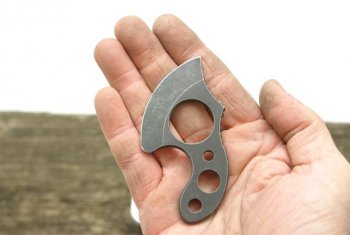KCorn
Well-Known Member
OK. I finally took the leap and made an entire knife just for the purpose of testing it's performance and then getting it to fail no matter what it took. We had a trip planned to go to Colorado so I rushed to make the knife so I could test it with some good chopping and firewood prep. The 1084 blade is very similar to the Survive knives GSO 7/7. A 6 3/4" blade and about a 5" handle. Micarta scales that attach with torx screws. The top 1/3 of the blade was coated with satanite and allowed to cure for 24 hours then heated to non magnetic in my forge and quenched in maxim fast oil (about 9 sec oil). Then tempered at 425 degrees for 2 hours.
Overall I was very impressed with its chopping and edge holding. It did not maintain a shaving sharp edge for quite as long as I would have liked but there was no noticeable edge rolling or chipping. At the end of our trip my son and I stuck the tip of the knife in a log and tried to pry a chunk of wood out. It really didn't take much lateral force to break about .5" off the blade. We then found a crack in the log and jammed the knife down about 1/3 of the way down and again pulled it to the side. It bent maybe 45 degrees and then snapped clean in two.
My question is this: What do you Dogs think I could do to improve the performance of the next big chopper I make. I know 1084 is capable of more than what I saw with the right heat treating. Give me your suggestions gang. I'm open for anything. Thanks!!
Overall I was very impressed with its chopping and edge holding. It did not maintain a shaving sharp edge for quite as long as I would have liked but there was no noticeable edge rolling or chipping. At the end of our trip my son and I stuck the tip of the knife in a log and tried to pry a chunk of wood out. It really didn't take much lateral force to break about .5" off the blade. We then found a crack in the log and jammed the knife down about 1/3 of the way down and again pulled it to the side. It bent maybe 45 degrees and then snapped clean in two.
My question is this: What do you Dogs think I could do to improve the performance of the next big chopper I make. I know 1084 is capable of more than what I saw with the right heat treating. Give me your suggestions gang. I'm open for anything. Thanks!!

